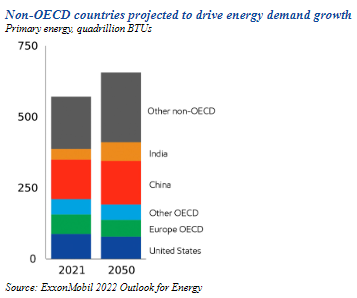Energy for transportation (cars, trucks, ships, trains and planes) will increase by more than 30% between 2021 and 2050, according to ExxonMobil projections.
At the same time, the company expects transportation energy demand to account for about 65% of the growth in liquid fuel demand worldwide during this period.
ExxonMobil recorded revenues of 413.68 billion dollars in 2022, with net profits of 55.74 billion.

This U.S. company reported 62,000, 63,000 and 72,000 at the end of 2022, 2021 and 2020, respectively.
Demand for liquid fuels by light vehicles is expected to peak around 2025, then decline to early 2000s levels by 2050, as the impact of increased fuel economy and significant growth in electric cars, led by China, Europe and the United States, offset the nearly 70% growth in the global car fleet.
By 2050, ExxonMobil forecasts that light-duty vehicles will account for about 15% of global liquid fuel demand.
Energy for transportation
During the same period, nearly all of the world’s commercial transport fleets are expected to continue to operate on liquid fuels, including biofuels, which are expected to be widely available and offer practical advantages by providing a large amount of energy in small volumes.
On the other hand, electricity supply by energy type will reflect significant differences between regions depending on a wide range of factors, including the cost and availability of different energy supplies and policy developments.
According to ExxonMobil’s forecast, global electricity demand will increase by more than 75% between 2021 and 2050, with developing countries likely to account for around 80% of the increase.
According to this forecast, electricity generation is expected to remain the largest and fastest-growing segment of global primary energy demand, supported by a wide variety of energy sources.
The share of coal-fired generation is also projected to decline substantially and approach 15% of global electricity in 2050, down from nearly 35% in 2021, in part due to policies to improve air quality and reduce greenhouse gas emissions to address climate change-related risks.
Electricity
From 2021 to 2050, the amount of electricity supplied by natural gas, nuclear and renewables is expected to more than double, accounting for all electricity supply growth and offsetting the reduction in coal.
Finally, ExxonMobil estimates that electricity from wind and solar will increase by more than 550%, contributing to total renewables (including other sources such as hydro) accounting for more than 80% of the increase in electricity supply worldwide through 2050.
Total renewables are expected to reach around 50% of global electricity supply by 2050.
Meanwhile, natural gas and nuclear power will account for 25% and 10%, respectively, of global electricity supply in 2050.

